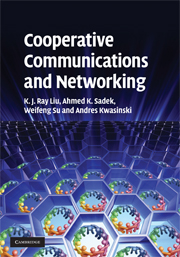Book contents
- Frontmatter
- Contents
- Preface
- Part I Background and MIMO systems
- Part II Cooperative communications
- Part III Cooperative networking
- 11 Cognitive multiple access via cooperation
- 12 Content-aware cooperative multiple access
- 13 Distributed cooperative routing
- 14 Source–channel coding with cooperation
- 15 Asymptotic performance of distortion exponents
- 16 Coverage expansion with cooperation
- 17 Broadband cooperative communications
- 18 Network lifetime maximization via cooperation
- References
- Index
15 - Asymptotic performance of distortion exponents
from Part III - Cooperative networking
Published online by Cambridge University Press: 06 July 2010
- Frontmatter
- Contents
- Preface
- Part I Background and MIMO systems
- Part II Cooperative communications
- Part III Cooperative networking
- 11 Cognitive multiple access via cooperation
- 12 Content-aware cooperative multiple access
- 13 Distributed cooperative routing
- 14 Source–channel coding with cooperation
- 15 Asymptotic performance of distortion exponents
- 16 Coverage expansion with cooperation
- 17 Broadband cooperative communications
- 18 Network lifetime maximization via cooperation
- References
- Index
Summary
In Chapter 13 we argued that cooperation can benefit the layers of the communication stack that are above the physical layer, where the idea was approached through the study of distributed cooperative routing. In Chapter 14 cooperation was studied as combined with source and channel coding, which extends the use of cooperation with the higher application layer. In fact, when considering that the benefits of cooperation come from the degree of diversity it provides, it is important to also recognize that diversity is not exclusive to implementations at the physical layer. Diversity can also be formed when multiple channels are provided to the application layer, where they are exploited through the use of multiple description source encoders. In multiple description coding different descriptions of the source are generated with the property that they can each be individually decoded or, if possible, be jointly decoded to obtain a reconstruction of the source with lower distortion. More importantly, a multiple description stream provides diversity that can be exploited by sending each description through an independent channel. This form of diversity has been called source coding diversity. Similarly, if we consider channel coding instead of source coding as the originator of diversity, we would be generating channel coding diversity. This chapter focuses on studying systems that exhibit three forms of diversity: source coding diversity, channel coding diversity, and cooperation.
- Type
- Chapter
- Information
- Cooperative Communications and Networking , pp. 514 - 549Publisher: Cambridge University PressPrint publication year: 2008

